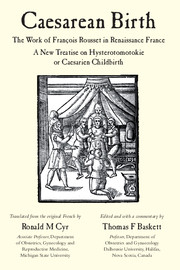 Caesarean Birth
Caesarean Birth Book contents
- Frontmatter
- Contents
- Acknowledgements
- Preface
- Translator's introduction
- François Rousset and the first text on caesarean section: a commentary by Thomas F Baskett
- A New Treatise on Hysterotomotokie or Caesarien Childbirth
- Sonnet
- Dedication
- Preface to the reader
- Part 1 Definition of caesarean childbirth
- Part 2 Second proof: logic (reason)
- Part 3 Third justification: expert opinion
- Part 4 Examples documenting other worse dangers from similar operations that are not caesarean
- Part 5 Other more popular justifications
- Part 6 On the fertility that remains after caesarean section
- A short guide to surgeons on the technique of caesarean
- Approbation
- Copyright
- Appendix 1 Summary of 16th century French history
- Appendix 2 Renée de France (1510–1575), Duchess of Ferrara, Chartres, Montargis and Nemours
- Appendix 3 Jacques de Savoie-Nemours (1531–1585), Duc de Nemours and Genevois
- Index
François Rousset and the first text on caesarean section: a commentary by Thomas F Baskett
Published online by Cambridge University Press: 05 June 2014
- Frontmatter
- Contents
- Acknowledgements
- Preface
- Translator's introduction
- François Rousset and the first text on caesarean section: a commentary by Thomas F Baskett
- A New Treatise on Hysterotomotokie or Caesarien Childbirth
- Sonnet
- Dedication
- Preface to the reader
- Part 1 Definition of caesarean childbirth
- Part 2 Second proof: logic (reason)
- Part 3 Third justification: expert opinion
- Part 4 Examples documenting other worse dangers from similar operations that are not caesarean
- Part 5 Other more popular justifications
- Part 6 On the fertility that remains after caesarean section
- A short guide to surgeons on the technique of caesarean
- Approbation
- Copyright
- Appendix 1 Summary of 16th century French history
- Appendix 2 Renée de France (1510–1575), Duchess of Ferrara, Chartres, Montargis and Nemours
- Appendix 3 Jacques de Savoie-Nemours (1531–1585), Duc de Nemours and Genevois
- Index
Summary
A brief biography
François Rousset (c1530–1603) was born in Pithiviers, France. After completing his classical studies in Orléans and Paris, he spent two years attending the lectures of Jacques duBois (1478–1555), the famous professor of medicine at the University of Paris, better known by his Latin cognomen, Sylvius. Rousset then moved to Montpellier to join the classes of the professor of medicine, Guillaume Rondelet (1507–1566), an early practitioner of human dissection. There, he received his Bachelor of Medicine degree and was granted his medical licence after passing the examinations and presenting a thesis. In Montpellier, the separation of surgery and academic medicine was not as pronounced as it was in Paris, so it is possible that Rousset had some exposure to the practical aspects of surgery. He had to abandon his doctoral studies because an outbreak of plague in Montpellier forced his move to Avignon.
After some months teaching and practising medicine in Avignon, the itinerant Rousset travelled throughout France, seeking to learn from other prominent physicians. After serving an apprenticeship with Nicolas de Villeneuve in Valréas, Provence, he returned to Paris, probably in 1554, and continued his attendance at Sylvius' lectures. It was on the latter's advice that he returned to practise in his hometown of Pithiviers around 1556. Here, his experience and reputation grew and he was ultimately called upon to attend ancient and noble families in the area, becoming physician to the Duchess of Ferrara (Appendix 2), the Duke of Nemours (Appendix 3), Catherine de Medici and, finally, Henry IV.
- Type
- Chapter
- Information
- Caesarean BirthThe Work of François Rousset in Renaissance France - A New Treatise on Hysterotomotokie or Caesarian Childbirth, pp. 1 - 16Publisher: Cambridge University PressPrint publication year: 2010


